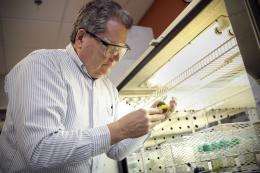New lignin 'lite' switchgrass boosts biofuel yield by more than one-third

Bioethanol from new lines of native perennial prairie grass could become less costly because of plant engineering by The Samuel Roberts Noble Foundation and fermentation research at Oak Ridge National Laboratory.
In a paper published in the Proceedings of the National Academy of Sciences, researchers describe their transgenic version of switchgrass as one that produces about one-third more ethanol by fermentation than conventional switchgrass. This improved plant feedstock will be able to generate more biofuel per acre, benefiting not only the transportation sector but also the growers and farming community.
"Recalcitrance, or a plant's natural defenses against insects, fungus and the weather, is widely acknowledged as being the single biggest barrier to the production of biofuel and biochemicals from switchgrass and other lignocellulosic materials," said Jonathan Mielenz, a co-author and member of the Department of Energy lab's BioEnergy Science Center.
For years researchers have sought better ways to break down the plant's defense system, and while substantial progress has been reported, recalcitrance remains a significant challenge.
Despite this obstacle, switchgrass holds great promise as a bioenergy feedstock because it is a native perennial plant, grows with high yields and requires little nitrogen and water. These characteristics made it an attractive target for transgenic improvements.
To achieve their goal, a team led by Zeng Yu Wang of The Samuel Roberts Noble Foundation in Ardmore, Okla., chose to "downregulate" – a process that involves decreasing a cellular component – the caffeic acid 3-O-methyltransferase, or COMT, gene – in the Alamo variety of switchgrass. This change decreased the plant's structural "glue," lignin, by about one-eighth. The scientists chose this gene based on encouraging results of lignin modification from previous Noble research conducted in alfalfa and other plant species.
What the team from the Noble Foundation ended up with, as discovered by a team led by Mielenz, is a switchgrass that is more easily converted to biofuels under milder conditions and with much lower costly additions during fermentation.
"The presence of lignin in plant cell walls interferes with the fermentation to produce biofuels," said Wang, who noted that enzymes are the single largest processing cost component for bioconversion of biomass after the biomass itself. "The transgenic lines require lower temperature preprocessing and only one-quarter to one-third the level of enzymes for equivalent ethanol fermentation compared to the unmodified switchgrass. This significantly lowers the cost of biofuels and biochemicals from this switchgrass."
More information: The paper, titled "Genetic manipulation of lignin reduces recalcitrance and improves ethanol production from switchgrass," will be published online this week.
Provided by Oak Ridge National Laboratory


















